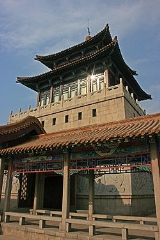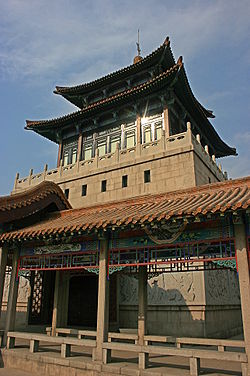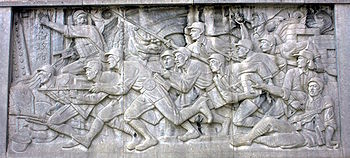
Jinan Liberation Pavilion
Encyclopedia

Jinan
Jinan is the capital of Shandong province in Eastern China. The area of present-day Jinan has played an important role in the history of the region from the earliest beginnings of civilisation and has evolved into a major national administrative, economic, and transportation hub...
, Shandong
Shandong
' is a Province located on the eastern coast of the People's Republic of China. Shandong has played a major role in Chinese history from the beginning of Chinese civilization along the lower reaches of the Yellow River and served as a pivotal cultural and religious site for Taoism, Chinese...
Province by the People's Liberation Army
People's Liberation Army
The People's Liberation Army is the unified military organization of all land, sea, strategic missile and air forces of the People's Republic of China. The PLA was established on August 1, 1927 — celebrated annually as "PLA Day" — as the military arm of the Communist Party of China...
during the Battle of Jinan
Battle of Jinan
The Battle of Jinan was a critical engagement fought between the Kuomintang and the Communist Party of China from during theChinese Civil War...
in the Chinese Civil War
Chinese Civil War
The Chinese Civil War was a civil war fought between the Kuomintang , the governing party of the Republic of China, and the Communist Party of China , for the control of China which eventually led to China's division into two Chinas, Republic of China and People's Republic of...
.
The Liberation Pavilion stands in the inner south-eastern corner of the ancient city moat near the site where the troops of People's Liberation Army
People's Liberation Army
The People's Liberation Army is the unified military organization of all land, sea, strategic missile and air forces of the People's Republic of China. The PLA was established on August 1, 1927 — celebrated annually as "PLA Day" — as the military arm of the Communist Party of China...
where able to breach the city wall on September 24 1948. The city wall has since been removed.
Construction of the pavilion was completed in September 1986. The entire structure stands about 34 meters tall and occupies an area of 617 square meters. Its overall architectural design follows classical Chinese patterns. Set on broad stone pedestal, the pavilion proper has two stories and is capped by an eaved roof. However, the sides of the pedestal are decorated with bas-relief
Relief
Relief is a sculptural technique. The term relief is from the Latin verb levo, to raise. To create a sculpture in relief is thus to give the impression that the sculpted material has been raised above the background plane...
stone carvings that depict scenes from the civil-war battle for Jinan in the style of Socialist realism
Socialist realism
Socialist realism is a style of realistic art which was developed in the Soviet Union and became a dominant style in other communist countries. Socialist realism is a teleologically-oriented style having its purpose the furtherance of the goals of socialism and communism...
. Another notable decorative feature of the pavilion are the gilded relief inscriptions that read "Liberation Pavilion" on the stone pedestal as well as on the pavilion proper. The characters of these inscriptions were taken from the handwriting of Marshal Chen Yi
Chen Yi (communist)
Chen Yi was a Chinese communist military commander and politician. He served as the 2nd Mayor of Shanghai and the 2nd Foreign Minister of China.-Biography:Chen was born in Lezhi, near Chengdu, Sichuan, into a moderately wealthy magistrate's family....
, who commanded the Shandong counter-offensive during the Chinese Civil War. The interior of the pavilion houses an exhibition related to the civil war battle for Jinan.


